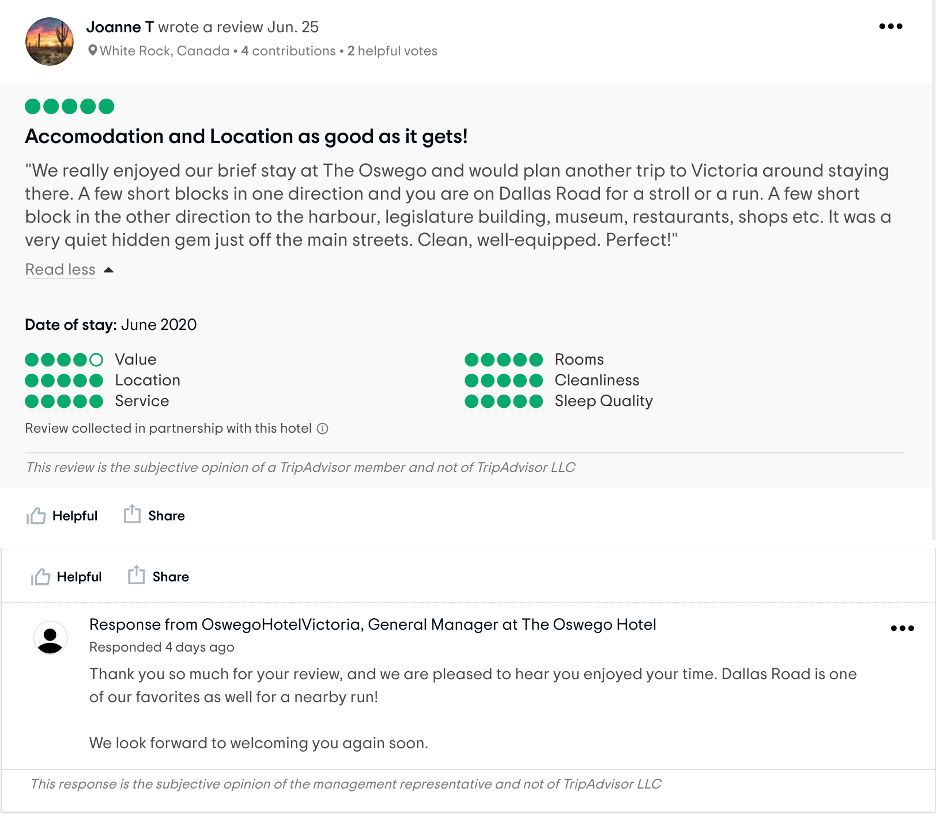9.3: Exceeding Expectations with Remarkable Service
- Page ID
- 9355
\( \newcommand{\vecs}[1]{\overset { \scriptstyle \rightharpoonup} {\mathbf{#1}} } \)
\( \newcommand{\vecd}[1]{\overset{-\!-\!\rightharpoonup}{\vphantom{a}\smash {#1}}} \)
\( \newcommand{\id}{\mathrm{id}}\) \( \newcommand{\Span}{\mathrm{span}}\)
( \newcommand{\kernel}{\mathrm{null}\,}\) \( \newcommand{\range}{\mathrm{range}\,}\)
\( \newcommand{\RealPart}{\mathrm{Re}}\) \( \newcommand{\ImaginaryPart}{\mathrm{Im}}\)
\( \newcommand{\Argument}{\mathrm{Arg}}\) \( \newcommand{\norm}[1]{\| #1 \|}\)
\( \newcommand{\inner}[2]{\langle #1, #2 \rangle}\)
\( \newcommand{\Span}{\mathrm{span}}\)
\( \newcommand{\id}{\mathrm{id}}\)
\( \newcommand{\Span}{\mathrm{span}}\)
\( \newcommand{\kernel}{\mathrm{null}\,}\)
\( \newcommand{\range}{\mathrm{range}\,}\)
\( \newcommand{\RealPart}{\mathrm{Re}}\)
\( \newcommand{\ImaginaryPart}{\mathrm{Im}}\)
\( \newcommand{\Argument}{\mathrm{Arg}}\)
\( \newcommand{\norm}[1]{\| #1 \|}\)
\( \newcommand{\inner}[2]{\langle #1, #2 \rangle}\)
\( \newcommand{\Span}{\mathrm{span}}\) \( \newcommand{\AA}{\unicode[.8,0]{x212B}}\)
\( \newcommand{\vectorA}[1]{\vec{#1}} % arrow\)
\( \newcommand{\vectorAt}[1]{\vec{\text{#1}}} % arrow\)
\( \newcommand{\vectorB}[1]{\overset { \scriptstyle \rightharpoonup} {\mathbf{#1}} } \)
\( \newcommand{\vectorC}[1]{\textbf{#1}} \)
\( \newcommand{\vectorD}[1]{\overrightarrow{#1}} \)
\( \newcommand{\vectorDt}[1]{\overrightarrow{\text{#1}}} \)
\( \newcommand{\vectE}[1]{\overset{-\!-\!\rightharpoonup}{\vphantom{a}\smash{\mathbf {#1}}}} \)
\( \newcommand{\vecs}[1]{\overset { \scriptstyle \rightharpoonup} {\mathbf{#1}} } \)
\( \newcommand{\vecd}[1]{\overset{-\!-\!\rightharpoonup}{\vphantom{a}\smash {#1}}} \)
\(\newcommand{\avec}{\mathbf a}\) \(\newcommand{\bvec}{\mathbf b}\) \(\newcommand{\cvec}{\mathbf c}\) \(\newcommand{\dvec}{\mathbf d}\) \(\newcommand{\dtil}{\widetilde{\mathbf d}}\) \(\newcommand{\evec}{\mathbf e}\) \(\newcommand{\fvec}{\mathbf f}\) \(\newcommand{\nvec}{\mathbf n}\) \(\newcommand{\pvec}{\mathbf p}\) \(\newcommand{\qvec}{\mathbf q}\) \(\newcommand{\svec}{\mathbf s}\) \(\newcommand{\tvec}{\mathbf t}\) \(\newcommand{\uvec}{\mathbf u}\) \(\newcommand{\vvec}{\mathbf v}\) \(\newcommand{\wvec}{\mathbf w}\) \(\newcommand{\xvec}{\mathbf x}\) \(\newcommand{\yvec}{\mathbf y}\) \(\newcommand{\zvec}{\mathbf z}\) \(\newcommand{\rvec}{\mathbf r}\) \(\newcommand{\mvec}{\mathbf m}\) \(\newcommand{\zerovec}{\mathbf 0}\) \(\newcommand{\onevec}{\mathbf 1}\) \(\newcommand{\real}{\mathbb R}\) \(\newcommand{\twovec}[2]{\left[\begin{array}{r}#1 \\ #2 \end{array}\right]}\) \(\newcommand{\ctwovec}[2]{\left[\begin{array}{c}#1 \\ #2 \end{array}\right]}\) \(\newcommand{\threevec}[3]{\left[\begin{array}{r}#1 \\ #2 \\ #3 \end{array}\right]}\) \(\newcommand{\cthreevec}[3]{\left[\begin{array}{c}#1 \\ #2 \\ #3 \end{array}\right]}\) \(\newcommand{\fourvec}[4]{\left[\begin{array}{r}#1 \\ #2 \\ #3 \\ #4 \end{array}\right]}\) \(\newcommand{\cfourvec}[4]{\left[\begin{array}{c}#1 \\ #2 \\ #3 \\ #4 \end{array}\right]}\) \(\newcommand{\fivevec}[5]{\left[\begin{array}{r}#1 \\ #2 \\ #3 \\ #4 \\ #5 \\ \end{array}\right]}\) \(\newcommand{\cfivevec}[5]{\left[\begin{array}{c}#1 \\ #2 \\ #3 \\ #4 \\ #5 \\ \end{array}\right]}\) \(\newcommand{\mattwo}[4]{\left[\begin{array}{rr}#1 \amp #2 \\ #3 \amp #4 \\ \end{array}\right]}\) \(\newcommand{\laspan}[1]{\text{Span}\{#1\}}\) \(\newcommand{\bcal}{\cal B}\) \(\newcommand{\ccal}{\cal C}\) \(\newcommand{\scal}{\cal S}\) \(\newcommand{\wcal}{\cal W}\) \(\newcommand{\ecal}{\cal E}\) \(\newcommand{\coords}[2]{\left\{#1\right\}_{#2}}\) \(\newcommand{\gray}[1]{\color{gray}{#1}}\) \(\newcommand{\lgray}[1]{\color{lightgray}{#1}}\) \(\newcommand{\rank}{\operatorname{rank}}\) \(\newcommand{\row}{\text{Row}}\) \(\newcommand{\col}{\text{Col}}\) \(\renewcommand{\row}{\text{Row}}\) \(\newcommand{\nul}{\text{Nul}}\) \(\newcommand{\var}{\text{Var}}\) \(\newcommand{\corr}{\text{corr}}\) \(\newcommand{\len}[1]{\left|#1\right|}\) \(\newcommand{\bbar}{\overline{\bvec}}\) \(\newcommand{\bhat}{\widehat{\bvec}}\) \(\newcommand{\bperp}{\bvec^\perp}\) \(\newcommand{\xhat}{\widehat{\xvec}}\) \(\newcommand{\vhat}{\widehat{\vvec}}\) \(\newcommand{\uhat}{\widehat{\uvec}}\) \(\newcommand{\what}{\widehat{\wvec}}\) \(\newcommand{\Sighat}{\widehat{\Sigma}}\) \(\newcommand{\lt}{<}\) \(\newcommand{\gt}{>}\) \(\newcommand{\amp}{&}\) \(\definecolor{fillinmathshade}{gray}{0.9}\)
Kim defines customer orientation “as the set of activities, behaviours, and beliefs that place high priority on customers’ interests and continuously create superior customer value” (2008, p. 195). Even when employees have positive attributes, it may not be enough to ensure positive customer engagements unless they are specifically trained toward customer orientation (Kim, 2008).
Customer Service and Competition: The Customer-Oriented Organization
According to Masberg and colleagues, “to the customer, only service may distinguish a business from its competition” (Masberg, Chase, & Madlem, 2003, p. 19). While specific customer service jobs require different skills, building an overall customer-oriented organization may better meet customer expectations. One way to ensure quality service may be to encourage tourism and hospitality professionals to acquire industry certifications. Businesses can also choose to implement tools to determine customer satisfactions levels, such as the SERVQUAL technique that compares customer perceptions of quality against customer expectations (Morrison, 2010). Under the SERVQUAL model, the five dimensions of service are:
- Reliability: where the quality and level of service is consistent
- Assurance: knowledge and courtesy of staff and their ability to convey trust and confidence
- Tangibles: the organization’s physical facilities, equipment, and appearance of staff
- Empathy: the degree of caring, individualized attention that the organization’s staff provide to its customers
- Responsiveness: the willingness of staff to help customers and provide prompt service
You can remember these five dimensions by using the acronym RATER. When these dimensions are consistently met, a company is well on its way to becoming customer oriented.
Spotlight On: Skills BC
Skills Canada BC engages a rich network of educators, labour, industry and government partners to deliver its programs and host its annual Regional and Provincial Olympic-style competitions. For more information, visit the Skills Canada BC website.
So far we’ve explored the reasons good customer service is critical to our industry. And with the acronym RATER, we now understand the basics of what a customer might expect from an organization. Together, these concepts can form part of a customer relationship management (CRM) strategy for tourism and hospitality businesses. CRMs are tools used by businesses to select customers and maintain relationships with them to increase their lifetime value to the business.
There are a number of points in time where this relationship is maintained. For example:
- The first time potential guests visit a website and leave their email address to receive more information
- The moment a reservation is made and the company captures their personal details
- The in-person service encounters from the front desk to the parking lot
- Welcome notes, personalized menus, friendly hellos, and other touches throughout the interaction
- Background messages including clean facilities and equipment in good repair, pleasant decor and ambiance (flowers, etc.)
- Follow-up communications like a newsletter
- Further interactions on social media
All of these touch points are opportunities to maintain strong relationships with customers and to increase the likelihood of positive word of mouth sharing. Let’s take a closer look at the role of social media in customer satisfaction.
The Role of Service and Social Media in Customer Satisfaction

While the basics of great service haven’t changed, social media and networking have raised the stakes in the service industry. The cost of a negative experience is higher — but so is the value of a positive experience. In fact, the opportunities of social media reviews and ratings far outweigh the risks.
Businesses that take time to “listen” to social media are going to be more successful at leveraging the power of online interactions. These companies effectively read review sites such as TripAdvisor, Yelp, and others and respond to guest comments both good and bad.
Many factors contribute to how people rate businesses, including value, quality, and convenience. More than anything, however, service influences customer impressions. Whereas a lapse in quality or convenience can be overcome with excellent service, it is especially challenging to overcome the effects of bad service.
Long Descriptions
Figure 9.9 long description: An online review of a hotel, dated June 25, 2020. The review is titled, “Accomodation [sic] and Location as good as it gets!”
The customer has written, “We really enjoyed our brief stay at The Oswego and would plan another trip to Victoria around staying there. A few short blocks in one direction and you are on Dallas Road for a stroll or a run. A few short block [sic] in the other direction to the harbour, legislature building, museum, restaurants, shops etc. It was a very quiet hidden gem just off the main streets. Clean, well-equipped. Perfect!”
The general manager wrote back, “Thank you so much for your review, and we are pleased to hear you enjoyed your time. Dallas Road is one of our favorites as well for a nearby run! We look forward to welcoming you again soon.”
On a scale of 1 to 5, the customer rated the hotel a 5 for location, service, rooms, cleanliness, and sleep quality. The customer gave the hotel a 4 for value.
[Return to Figure 9.9]


